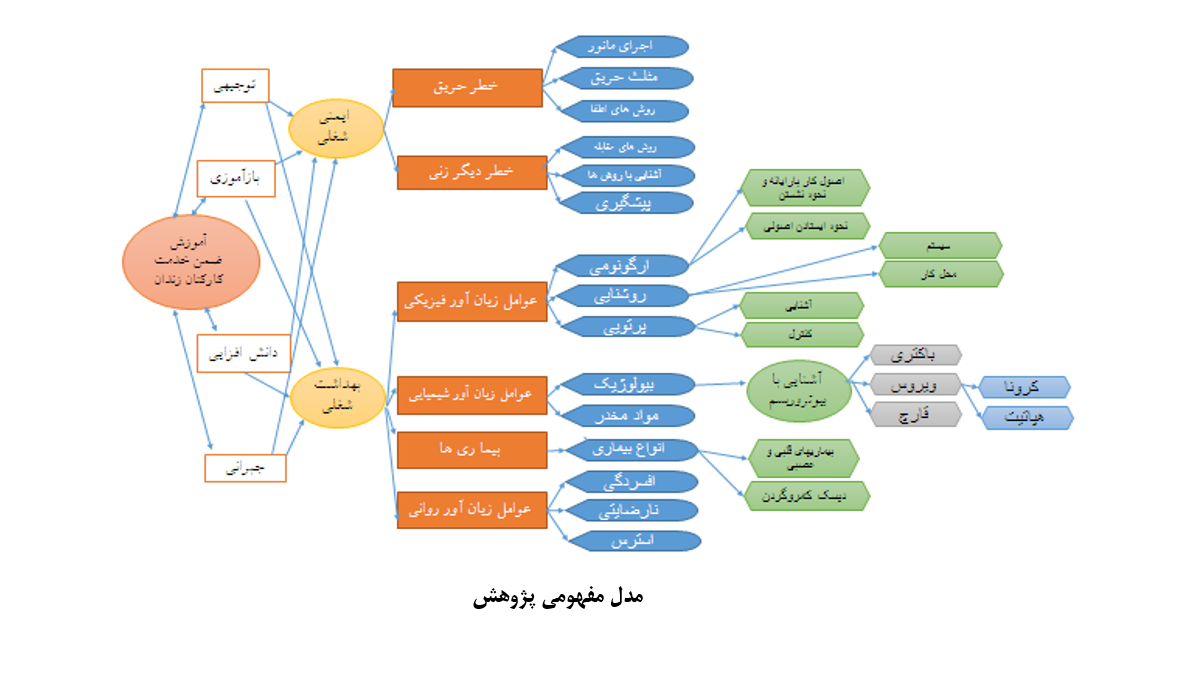Examining the Impact of In-Service Training on Safety and Health Indicators of Employees in the Prison Organization Using Structural Equation Modeling and Factor Analysis
Keywords:
Safety, Health, Prison Organization, Factor Analysis, In-Service TrainingAbstract
The primary objective of this study is to examine the impact of in-service training on safety and health indicators in the Prison Organization, analyzed using factor analysis. This study is applied in terms of its objective and descriptive-analytical in terms of its execution. A researcher-developed questionnaire was designed with 27 questions based on the conceptual model of the study. The statistical population consisted of 2,875 individuals, and the sample size was determined to be 261 participants. The questionnaire was distributed among employees and experts of the Prison Organization and the Correctional and Rehabilitation Measures Organization. The findings indicated that in the safety component, familiarity with the fire triangle, conducting fire drills, and learning various fire extinguishing methods ranked first to third in priority. In the health component, computer screen lighting, prevention of lumbar and cervical disc disorders, and reduction of job dissatisfaction were identified as the top three priorities. Therefore, it is essential that in-service training for employees of the Prison Organization be conducted in a targeted manner.
Downloads
References
Sotoudeh Moghadam M, Cherabin M, Akbari A, Zendedel A. Designing the Policy Model of In-Service Training Suitable for the Professional Development of Teachers. Iranian Journal of Educational Sociology. 2024;7(1):166-78. doi: 10.61838/kman.ijes.7.1.16.
Naltan CU. Exploring Factors Influencing in-Service Teachers' Motivation to Teach English in Thailand. Hum Behav Dev Soc. 2024;25(1):63-74. doi: 10.62370/hbds.v25i1.270098.
Ford D. Bottom-line training: Texas Gulf Publishing Company; 2001.
Kiani F, Samavatiyan H, Pour Abadian S, Mansour Nejad Z, Jafari I. The effectiveness of safety training on changing employees' attitudes towards safety issues: A pathological study. Journal of the School of Public Health and Health Research Institute. 2011;9(2).
Mahara KK. Receiving and Implementing in-Service Teacher Training Programmes: Identifying Challenges From Teachers’ Perspectives. KMC Journal. 2024;6(1):153-75. doi: 10.3126/kmcj.v6i1.62338.
Keykha Z, Sadeghi A, Rashki S, editors. Investigating the Role of In-Service Training on Enhancing Entrepreneurship and Creativity of Exceptional School Teachers in Zahedan2023.
Jahani A, Kamali N, Davoodi R. Identifying the Effective Factors influencing In-Service Training of Employees at the Red Crescent Society of Zanjan Province. Sci J Rescue Relief. 2023;15(1):1-8. doi: 10.32592/jorar.2023.15.1.1.
Albrechtsen E, Solberg I, Svensli E. The application and benefits of job safety analysis. Safety Science. 2018.
Pour Soleiman Omran M, Tokali Erdogan S, Ismailzadeh F, Alizadeh Firouzi M. Pathology of in-service training in Faraja with a trifurcation model. Education in Police Sciences. 2022;10(38):111-38.
Vu TV, Vo-Thanh T, Nguyen PN, Duy Van N. The COVID-19 pandemic: Workplace safety management practices, job insecurity, and employees' organizational citizenship behavior. 2022.
Yaghoubi N, Kougir YA. Familiarization with occupational diseases and how to prevent them: Shahid Bolandian Health Center; 2016.
Minwalkulet BN. Employee Work Place Safety, Job Satisfaction and Organizational Commitment. Research on Humanities and Social Sciences. 2019;9(5):1-12. doi: 10.7176/RHSS/9-5-07.
Parsafard H, Homayoun Arya S. Investigating the role of specialized in-service training in empowering employees. Organizational Development of Police. 2018;15(64):87-116.
Abbasi S, editor Investigating the impact of in-service training on the job performance of employees in the Tehran Fire Department and Safety Services. Third National Conference on Firefighting and Urban Safety, Tehran; 2017.
Halvani G, Radpour J, Shoja I, Gholami Arjanki S, Khalifeh Y. Investigating the impact of training on risk assessment codes using a quantitative job safety analysis in one of the cement production units. Occupational Medicine. 2016;8(1):20-33.
Hosseini HS, Abedi Nia S, Yadollahzadeh M, editors. Identification and evaluation of occupational hazards using the JSA method in an oil company. International Conference on Sciences, Engineering, and Environmental Technologies, Tehran, Faculty of Environment, University of Tehran; 2015.
Fathi Vajargah K. In-service training planning for employees: Organization for the Study and Compilation of Humanities Books of Universities (SAMT), Center for Research and Development of Humanities, Tehran; 2011.

Downloads
Published
Submitted
Revised
Accepted
Issue
Section
License
Copyright (c) 2025 Kamran Pakmanesh (Author); Mahmoud Haghani (Corresponding author); Mahmoud Abolghasemi (Author)

This work is licensed under a Creative Commons Attribution-NonCommercial 4.0 International License.










